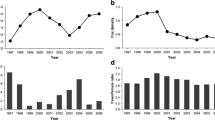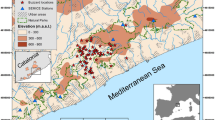Abstract
In prey communities with shared predators, variation in prey vulnerability is a key factor in shaping community dynamics. Conversely, the hunting efficiency of a predator depends on the prey community structure, preferences of the predator and antipredatory behavioural traits of the prey. We studied experimentally, under seminatural field conditions, the preferences of a predator and the antipredatory responses of prey in a system consisting of two Myodes species of voles, the grey-sided vole (M. rufocanus Sund.) and the bank vole (M. glareolus Schreb.), and their specialist predator, the least weasel (Mustela nivalis nivalis L.). To quantify the preference of the weasels, we developed a new modelling framework that can be used for unbalanced data. The two vole species were hypothesised to have different habitat-dependent vulnerabilities. We created two habitats, open and forest, to provide different escape possibilities for the voles. We found a weak general preference of the weasels for the grey-sided voles over the bank voles, and a somewhat stronger preference specifically in open habitats. The weasels clearly preferred male grey-sided voles over females, whereas in bank voles, there was no difference. The activity of voles changed over time, so that voles increased their movements immediately after weasel introduction, but later adjusted their movements to times of lowered predation risk. Females that were more active had an elevated mortality risk, whereas in the case of males, the result was the opposite. We conclude that, in vulnerability to predation, the species- or habitat-specific characteristics of these prey species are playing a minor role compared to sex-specific characteristics.





Similar content being viewed by others
References
Abrams PA, Holt RD, Roth JD (1998) Apparent competition or apparent mutualism? Shared predation when populations cycle. Ecology 79:201–212
Banks PB, Norrdahl K, Korpimäki E (2000) Nonlinearity in the predation risk of prey mobility. Proc R Soc Lond B 267:1621–1625
Chase JM, Abrams PA, Grover JP, Diehl S, Chesson P, Holt RD, Richards SA, Nisbet RM, Case TJ (2002) The interaction between predation and competition: a review and synthesis. Ecol Lett 5:302–315
Christensen P, Hörnfeldt B (2006) Habitat preferences of Clethrionomys rufocanus in boreal Sweden. Landscape Ecol 21:185–194
Cushing BS (1985) Estrous mice and vulnerability to weasel predation. Ecology 66:1976–1978
Hanski I, Henttonen H (1996) Predation on competing rodent species: a simple explanation of complex patterns. J Anim Ecol 65:220–232
Hanski I, Hansson L, Henttonen H (1991) Specialist predators, generalist predators, and the microtine rodent cycle. J Anim Ecol 60:353–367
Henttonen H (1987) The impact of spacing behavior in microtine rodents on the dynamics of least weasels Mustela nivalis—a hypothesis. Oikos 50:366–370
Henttonen H (2000) Long-term dynamics of the bank vole Clethrionomys glareolus at Pallasjärvi, northern Finnish taiga. Polish J Ecol 48(Suppl):87–96
Henttonen H, Hansson L (1984) Interspecific relations between small rodents in European boreal and subarctic environments. Acta Zool Fenn 172:61–65
Holt RD (1977) Predation, apparent competition, and the structure of prey communities. Theor Popul Biol 12:197–229
Holt RD, Kotler BP (1987) Short-term apparent competition. Am Nat 130:412–430
Horne TJ, Ylönen H (1998) Heritabilities of dominance-related traits in male bank voles (Clethrionomys glareolus). Evolution 52:894–899
Jedrzejewska B, Jedrzejewski W (1990) Antipredatory behaviour of bank voles and prey choice of weasels—enclosure experiments. Ann Zool Fenn 27:321–328
Jedrzejewski W, Jedrzejewska B (1990) Effect of a predator’s visit on the spatial distribution of bank voles: experiments with weasels. Can J Zool 68:660–666
Jedrzejewski W, Rychlik L, Jedrzejewska B (1993) Responses of bank voles to odours of seven species of predators: experimental data and their relevance to natural predator–vole relationships. Oikos 68:251–257
Jensen B (1994) Suomen ja Pohjolan nisäkkäät. WSOY, Porvoo (in Finnish)
Kenward R (1987) Wildlife radio tagging: equipment, field techniques and data analysis. Academic Press, London
Klemme I, Eccard JA, Gerlach G, Horne TJ, Ylönen H (2006) Does it pay to be a dominant male in a promiscuous species? Ann Zool Fenn 43:248–257
Klemola T, Koivula M, Korpimäki E, Norrdahl K (1997) Small mustelid predation slows population growth of Microtus voles: a predator reduction experiment. J Anim Ecol 66:607–614
Korpimäki E, Norrdahl K, Rinta-Jaskari T (1991) Responses of stoats and least weasels to fluctuating food abundances: is the low phase of the vole cycle due to mustelid predation? Oecologia 88:552–561
Krebs CJ (1999) Ecological methodology, 2nd edn. Benjamin Cummings, Menlo Park, California
Lima SL, Bednekoff PA (1999) Temporal variation in danger drives antipredator behavior: the predation risk allocation hypothesis. Am Nat 153:649–659
Lima SL, Dill LM (1990) Behavioral decisions made under the risk of predation: a review and prospectus. Can J Zool 68:619–640
Menge BA, Sutherland JP (1976) Species diversity gradients: synthesis of the roles of predation, competition, and temporal heterogeneity. Am Nat 110:351–369
Menge BA, Sutherland JP (1987) Community regulation: variation in disturbance, competition, and predation in relation to environmental stress and recruitment. Am Nat 130:730–757
Norrdahl K, Korpimäki E (1993) Predation and interspecific competition in two Microtus voles. Oikos 67:149–158
Norrdahl K, Korpimäki E (1998) Does mobility or sex of voles affect risk of predation by mammalian predators? Ecology 79:226–232
Oksanen L (1992) Evolution of exploitation ecosystems I. Predation, foraging ecology and population dynamics in herbivores. Evol Ecol 6:15–33
Oksanen L, Lundberg P (1995) Optimization of reproductive effort and foraging time in mammals: the influence of resource level and predation risk. Evol Ecol 9:45–56
Pusenius J, Viitala J, Marienberg T, Ritvanen S (1998) Matrilineal kin clusters and their effect on reproductive success in the field vole Microtus agrestis. Behav Ecol 9:85–92
Sih A, Crowley P, McPeek M, Petranka J, Strohmeier K (1985) Predation, competition, and prey communities: a review of field experiments. Annu Rev Ecol Syst 16:269–311
Siivonen L, Sulkava S (1994) Mammals of northern Europe, 5th edn. Otava, Helsinki (in Finnish)
Sundell J (2003) Population dynamics of microtine rodents: an experimental test of the predation hypothesis. Oikos 101:416–427
Sundell J, Ylönen H (2004) Behaviour and choice of refuge by voles under predation risk. Behav Ecol Sociobiol 56:263–269
Sundell J, Norrdahl K, Korpimäki E, Hanski I (2000) Functional response of the least weasel, Mustela nivalis nivalis. Oikos 90:501–508
Sundell J, Eccard JA, Tiilikainen R, Ylönen H (2003) Predation rate, prey preference and predator switching: experiments on voles and weasels. Oikos 101:615–623
Viitala J (1977) Social organization in cyclic subarctic populations of the vole Clethrionomys rufocanus (Sund.) and Microtus agrestis (L.). Ann Zool Fenn 14:53–93
Wilson DE, Reeder DM (2005) Mammal species of the world, 3rd edn. Johns Hopkins University Press, Baltimore, Maryland
Wooster D, Sih A (1995) A review of the drift and activity responses of stream prey to predator presence. Oikos 73:3–8
Ylönen H, Sundell J, Tiilikainen R, Eccard JA, Horne TJ (2003) Weasels’ (Mustela nivalis nivalis) preference for olfactory cues of the vole (Clethrionomys glareolus). Ecology 84:1447–1452
Acknowledgments
J. Gustafsson, A. Hämäläinen, J. Häyrinen, K. Juutilainen, E. Knuutila, S. Niskanen, A. Reckordt and H. Vihervaara are acknowledged for their assistance during the field work. We thank J.O. Wolff for the valuable comments on the manuscript and A.-L. Laine for helping with the statistics analysis. The study was funded by the Academy of Finland (project nos. 208478 to JS, 44878 to HY and MH, and 205376 to OO), Swedish Research Council to TO and CIMO to LT. The experiment complies with the current laws of Finland.
Author information
Authors and Affiliations
Corresponding author
Rights and permissions
About this article
Cite this article
Sundell, J., Trebatická, L., Oksanen, T. et al. Predation on two vole species by a shared predator: antipredatory response and prey preference. Popul Ecol 50, 257–266 (2008). https://doi.org/10.1007/s10144-008-0086-4
Received:
Accepted:
Published:
Issue Date:
DOI: https://doi.org/10.1007/s10144-008-0086-4




